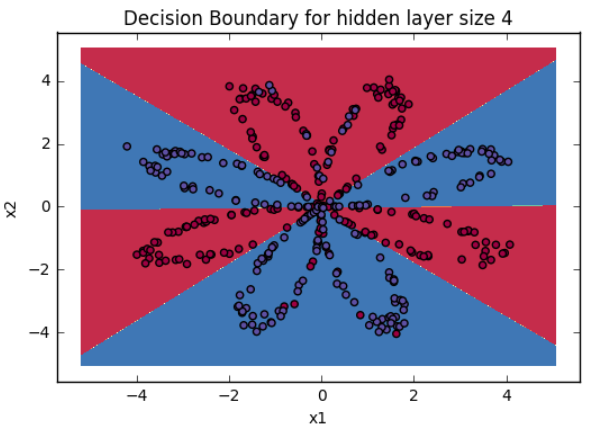Planar data classification with a hidden layer
Welcome to the second programming exercise of the deep learning specialization. In this notebook you will generate red and blue points to form a flower. You will then fit a neural network to correctly classify the points. You will try different layers and see the results.

By completing this assignment you will:
- Develop an intuition of back-propagation and see it work on data.
- Recognize that the more hidden layers you have the more complex structure you could capture.
- Build all the helper functions to implement a full model with one hidden layer.
This assignment prepares you well for the upcoming assignment. Take your time to complete it and make sure you get the expected outputs when working through the different exercises. In some code blocks, you will find a "#GRADED FUNCTION: functionName" comment. Please do not modify it. After you are done, submit your work and check your results. You need to score 70% to pass. Good luck :) !
【中文翻译】
用有一个人隐藏层的神经网络进行平面数据分类
Planar data classification with one hidden layer
Welcome to your week 3 programming assignment. It's time to build your first neural network, which will have a hidden layer. You will see a big difference between this model and the one you implemented using logistic regression.
You will learn how to:
- Implement a 2-class classification neural network with a single hidden layer
- Use units with a non-linear activation function, such as tanh
- Compute the cross entropy loss
- Implement forward and backward propagation
【中文翻译】
欢迎您的第3周的编程作业。是时候建立你的第一个神经网络了, 这将有一个隐藏层。你会看到这个模型和你使用逻辑回归实现的一个很大的不同。
--------------------------------------------------------------------------------------------------------------------------
1 - Packages
Let's first import all the packages that you will need during this assignment.
- numpy is the fundamental package for scientific computing with Python.
- sklearn provides simple and efficient tools for data mining and data analysis.
- matplotlib is a library for plotting graphs in Python.
- testCases provides some test examples to assess the correctness of your functions
- planar_utils provide various useful functions used in this assignment
【中文翻译】
# Package imports import numpy as np import matplotlib.pyplot as plt from testCases_v2 import * import sklearn import sklearn.datasets import sklearn.linear_model from planar_utils import plot_decision_boundary, sigmoid, load_planar_dataset, load_extra_datasets %matplotlib inline np.random.seed(1) # set a seed so that the results are consistent
2 - Dataset
First, let's get the dataset you will work on. The following code will load a "flower" 2-class dataset into variables X and Y.
【code】
X, Y = load_planar_dataset()
Visualize the dataset using matplotlib. The data looks like a "flower" with some red (label y=0) and some blue (y=1) points. Your goal is to build a model to fit this data.
【中文翻译】
使用 matplotlib 可视化数据集。数据看起来像一个 "花" ,由一些红色 (标签 y=0) 和一些蓝色 (y=1) 点组成。你的目标是建立一个模型来分类这些数据。
【code】
# Visualize the data: plt.scatter(X[0, :], X[1, :], c=Y, s=40, cmap=plt.cm.Spectral);
【result】
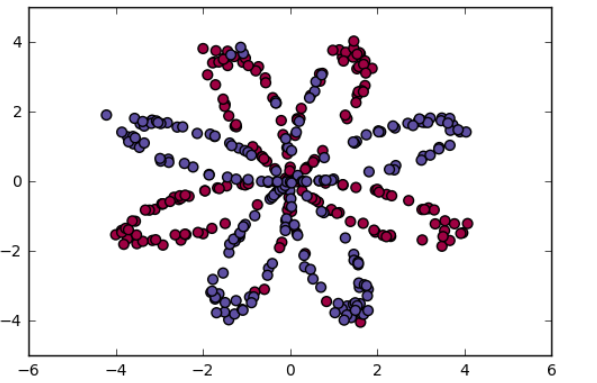
You have:
- a numpy-array (matrix) X that contains your features (x1, x2)
- a numpy-array (vector) Y that contains your labels (red:0, blue:1).
Lets first get a better sense of what our data is like.
Exercise: How many training examples do you have? In addition, what is the shape of the variables X and Y?
Hint: How do you get the shape of a numpy array? (help)
【code】
### START CODE HERE ### (≈ 3 lines of code) shape_X = X.shape shape_Y = Y.shape m = X.shape[1] # training set size ### END CODE HERE ### print ('The shape of X is: ' + str(shape_X)) print ('The shape of Y is: ' + str(shape_Y)) print ('I have m = %d training examples!' % (m))
【result】
The shape of X is: (2, 400) The shape of Y is: (1, 400) I have m = 400 training examples!
Expected Output:
| shape of X | (2, 400) |
| shape of Y | (1, 400) |
| m | 400 |
--------------------------------------------------------------------------------------------------------------------------
3 - Simple Logistic Regression
Before building a full neural network, lets first see how logistic regression performs on this problem. You can use sklearn's built-in functions to do that. Run the code below to train a logistic regression classifier on the dataset.
【code】
# Train the logistic regression classifier clf = sklearn.linear_model.LogisticRegressionCV(); clf.fit(X.T, Y.T);
You can now plot the decision boundary of these models. Run the code below.
【code】
# Plot the decision boundary for logistic regression plot_decision_boundary(lambda x: clf.predict(x), X, Y) plt.title("Logistic Regression") # Print accuracy LR_predictions = clf.predict(X.T) print ('Accuracy of logistic regression: %d ' % float((np.dot(Y,LR_predictions) + np.dot(1-Y,1-LR_predictions))/float(Y.size)*100) + '% ' + "(percentage of correctly labelled datapoints)")
【result】
Accuracy of logistic regression: 47 % (percentage of correctly labelled datapoints)
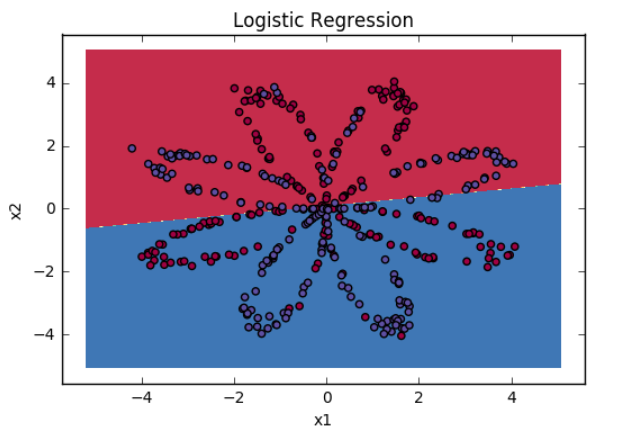
Expected Output:
| Accuracy | 47% |
Interpretation: The dataset is not linearly separable, so logistic regression doesn't perform well. Hopefully a neural network will do better. Let's try this now!
-------------------------------------------------------------------------------------------------------------------------
4 - Neural Network model
Logistic regression did not work well on the "flower dataset". You are going to train a Neural Network with a single hidden layer.
Here is our model:
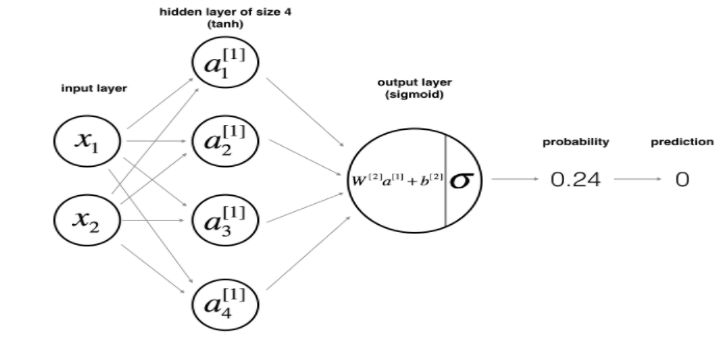
Mathematically:
For one example x(i)x(i):

Given the predictions on all the examples, you can also compute the cost J as follows:

Reminder: The general methodology to build a Neural Network is to:
1. Define the neural network structure ( # of input units, # of hidden units, etc).
2. Initialize the model's parameters
3. Loop:
- Implement forward propagation
- Compute loss
- Implement backward propagation to get the gradients
- Update parameters (gradient descent)
You often build helper functions to compute steps 1-3 and then merge them into one function we call nn_model(). Once you've built nn_model() and learnt the right parameters, you can make predictions on new data.
4.1 - Defining the neural network structure
Exercise: Define three variables:
- n_x: the size of the input layer
- n_h: the size of the hidden layer (set this to 4)
- n_y: the size of the output layer
Hint: Use shapes of X and Y to find n_x and n_y. Also, hard code the hidden layer size to be 4.
【code】
# GRADED FUNCTION: layer_sizes def layer_sizes(X, Y): """ Arguments: X -- input dataset of shape (input size, number of examples) Y -- labels of shape (output size, number of examples) Returns: n_x -- the size of the input layer n_h -- the size of the hidden layer n_y -- the size of the output layer """ ### START CODE HERE ### (≈ 3 lines of code) n_x = X.shape[0]# size of input layer n_h = 4 n_y = Y.shape[0] # size of output layer ### END CODE HERE ### return (n_x, n_h, n_y)
X_assess, Y_assess = layer_sizes_test_case() (n_x, n_h, n_y) = layer_sizes(X_assess, Y_assess) print("The size of the input layer is: n_x = " + str(n_x)) print("The size of the hidden layer is: n_h = " + str(n_h)) print("The size of the output layer is: n_y = " + str(n_y))
【result】
The size of the input layer is: n_x = 5 The size of the hidden layer is: n_h = 4 The size of the output layer is: n_y = 2
Expected Output (these are not the sizes you will use for your network, they are just used to assess the function you've just coded).
| n_x | 5 |
| n_h | 4 |
| n_y | 2 |
4.2 - Initialize the model's parameters
Exercise: Implement the function initialize_parameters().
Instructions:
- Make sure your parameters' sizes are right. Refer to the neural network figure above if needed.
- You will initialize the weights matrices with random values.
- Use:
np.random.randn(a,b) * 0.01to randomly initialize a matrix of shape (a,b).
- Use:
- You will initialize the bias vectors as zeros.
- Use:
np.zeros((a,b))to initialize a matrix of shape (a,b) with zeros.
- Use:
【code】
# GRADED FUNCTION: initialize_parameters def initialize_parameters(n_x, n_h, n_y): """ Argument: n_x -- size of the input layer n_h -- size of the hidden layer n_y -- size of the output layer Returns: params -- python dictionary containing your parameters: W1 -- weight matrix of shape (n_h, n_x) b1 -- bias vector of shape (n_h, 1) W2 -- weight matrix of shape (n_y, n_h) b2 -- bias vector of shape (n_y, 1) """ np.random.seed(2) # we set up a seed so that your output matches ours although the initialization is random. ### START CODE HERE ### (≈ 4 lines of code) W1 = np.random.randn(n_h,n_x)*0.01 b1 = np.zeros((n_h,1)) #注意zeros()函数初始化的写法 W2 = np.random.randn(n_y,n_h)*0.01 b2 = np.zeros((n_y,1)) ### END CODE HERE ### assert (W1.shape == (n_h, n_x)) assert (b1.shape == (n_h, 1)) assert (W2.shape == (n_y, n_h)) assert (b2.shape == (n_y, 1)) parameters = {"W1": W1, "b1": b1, "W2": W2, "b2": b2} return parameters
n_x, n_h, n_y = initialize_parameters_test_case() parameters = initialize_parameters(n_x, n_h, n_y) print("W1 = " + str(parameters["W1"])) print("b1 = " + str(parameters["b1"])) print("W2 = " + str(parameters["W2"])) print("b2 = " + str(parameters["b2"]))
【result】
W1 = [[-0.00416758 -0.00056267] [-0.02136196 0.01640271] [-0.01793436 -0.00841747] [ 0.00502881 -0.01245288]] b1 = [[ 0.] [ 0.] [ 0.] [ 0.]] W2 = [[-0.01057952 -0.00909008 0.00551454 0.02292208]] b2 = [[ 0.]]
Expected Output:
| W1 | [[-0.00416758 -0.00056267] [-0.02136196 0.01640271] [-0.01793436 -0.00841747] [ 0.00502881 -0.01245288]] |
| b1 | [[ 0.] [ 0.] [ 0.] [ 0.]] |
| W2 | [[-0.01057952 -0.00909008 0.00551454 0.02292208]] |
| b2 | [[ 0.]] |
4.3 - The Loop
Question: Implement forward_propagation().
Instructions:
- Look above at the mathematical representation of your classifier.
- You can use the function
sigmoid(). It is built-in (imported) in the notebook. - You can use the function
np.tanh(). It is part of the numpy library. - The steps you have to implement are:
- Retrieve each parameter from the dictionary "parameters" (which is the output of
initialize_parameters()) by usingparameters[".."]. - Implement Forward Propagation. Compute Z[1],A[1],Z[2]and A[2] (the vector of all your predictions on all the examples in the training set).
- Retrieve each parameter from the dictionary "parameters" (which is the output of
- Values needed in the backpropagation are stored in "
cache". Thecachewill be given as an input to the backpropagation function.
【中文翻译】
sigmoid()。它内置在笔记本中 (导入)。# GRADED FUNCTION: forward_propagation def forward_propagation(X, parameters): """ Argument: X -- input data of size (n_x, m) parameters -- python dictionary containing your parameters (output of initialization function) Returns: A2 -- The sigmoid output of the second activation cache -- a dictionary containing "Z1", "A1", "Z2" and "A2" """ # Retrieve each parameter from the dictionary "parameters" ### START CODE HERE ### (≈ 4 lines of code) W1 = parameters["W1"] # b1 = parameters["b1"] W2 = parameters["W2"] b2 = parameters["b2"] ### END CODE HERE ### # Implement Forward Propagation to calculate A2 (probabilities) ### START CODE HERE ### (≈ 4 lines of code) Z1 = np.dot(W1, X)+b1 A1 = np.tanh(Z1) Z2 = np.dot(W2,A1)+b2 A2 = sigmoid(Z2) ### END CODE HERE ### assert(A2.shape == (1, X.shape[1])) cache = {"Z1": Z1, "A1": A1, "Z2": Z2, "A2": A2} return A2, cache
# GRADED FUNCTION: forward_propagation def forward_propagation(X, parameters): """ Argument: X -- input data of size (n_x, m) parameters -- python dictionary containing your parameters (output of initialization function) Returns: A2 -- The sigmoid output of the second activation cache -- a dictionary containing "Z1", "A1", "Z2" and "A2" """ # Retrieve each parameter from the dictionary "parameters" ### START CODE HERE ### (≈ 4 lines of code) W1 = parameters["W1"] # b1 = parameters["b1"] W2 = parameters["W2"] b2 = parameters["b2"] ### END CODE HERE ### # Implement Forward Propagation to calculate A2 (probabilities) ### START CODE HERE ### (≈ 4 lines of code) Z1 = np.dot(W1, X)+b1 A1 = np.tanh(Z1) Z2 = np.dot(W2,A1)+b2 A2 = sigmoid(Z2) ### END CODE HERE ### assert(A2.shape == (1, X.shape[1])) cache = {"Z1": Z1, "A1": A1, "Z2": Z2, "A2": A2} return A2, cache
X_assess, parameters = forward_propagation_test_case() A2, cache = forward_propagation(X_assess, parameters) # Note: we use the mean here just to make sure that your output matches ours. print(np.mean(cache['Z1']) ,np.mean(cache['A1']),np.mean(cache['Z2']),np.mean(cache['A2']))
【result】
0.262818640198 0.091999045227 -1.30766601287 0.212877681719
Expected Output:
| 0.262818640198 0.091999045227 -1.30766601287 0.212877681719 |
Now that you have computed A[2] (in the Python variable "A2"), which contains a[2](i)for every example, you can compute the cost function as follows:

Exercise: Implement compute_cost() to compute the value of the cost J.
Instructions:
- There are many ways to implement the cross-entropy loss(损失熵). To help you, we give you how we would have implemented

logprobs = np.multiply(np.log(A2),Y) cost = - np.sum(logprobs) # no need to use a for loop!
(you can use either np.multiply() and then np.sum() or directly np.dot()).
【code】
# GRADED FUNCTION: compute_cost def compute_cost(A2, Y, parameters): """ Computes the cross-entropy cost given in equation (13) Arguments: A2 -- The sigmoid output of the second activation, of shape (1, number of examples) Y -- "true" labels vector of shape (1, number of examples) parameters -- python dictionary containing your parameters W1, b1, W2 and b2 Returns: cost -- cross-entropy cost given equation (13) """ m = Y.shape[1] # number of example # Compute the cross-entropy cost ### START CODE HERE ### (≈ 2 lines of code) logprobs = np.multiply(np.log(A2),Y)+ np.multiply(np.log(1-A2),1- Y) cost = - 1/m*np.sum(logprobs) ### END CODE HERE ### cost = np.squeeze(cost) # makes sure cost is the dimension we expect. # E.g., turns [[17]] into 17 assert(isinstance(cost, float)) #cost的类型是不是float return cost
A2, Y_assess, parameters = compute_cost_test_case() print("cost = " + str(compute_cost(A2, Y_assess, parameters)))
Expected Output:
| cost | 0.693058761... |
Using the cache computed during forward propagation, you can now implement backward propagation.
Question: Implement the function backward_propagation().
Instructions: Backpropagation is usually the hardest (most mathematical) part in deep learning. To help you, here again is the slide from the lecture on backpropagation. You'll want to use the six equations on the right of this slide, since you are building a vectorized implementation.
【中文翻译】
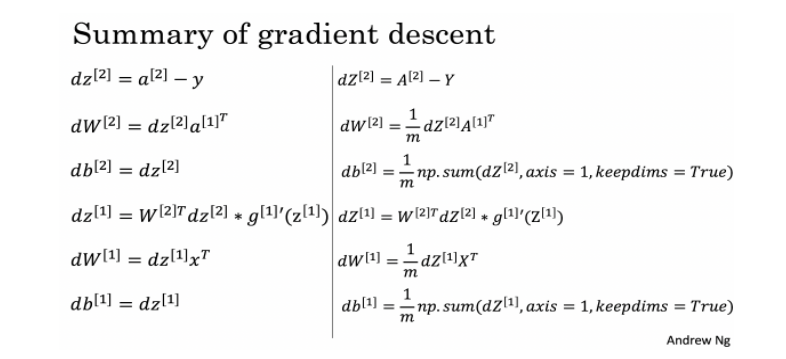
Tips:
- To compute dZ1 you'll need to compute g[1]′(Z[1]). Since g[1](.)is the tanh activation function, if a=g[1](z) then g[1]′(z)=1−a2. So you can compute g[1]′(Z[1]) using
(1 - np.power(A1, 2)).
【code】
# GRADED FUNCTION: backward_propagation def backward_propagation(parameters, cache, X, Y): """ Implement the backward propagation using the instructions above. Arguments: parameters -- python dictionary containing our parameters(W1,b1,W2,b2) cache -- a dictionary containing "Z1", "A1", "Z2" and "A2". X -- input data of shape (2, number of examples) Y -- "true" labels vector of shape (1, number of examples) Returns: grads -- python dictionary containing your gradients with respect to different parameters """ m = X.shape[1] # First, retrieve W1 and W2 from the dictionary "parameters". ### START CODE HERE ### (≈ 2 lines of code) W1 = parameters["W1"] W2 = parameters["W2"] ### END CODE HERE ### # Retrieve(检索) also A1 and A2 from dictionary "cache". ### START CODE HERE ### (≈ 2 lines of code) A1 = cache["A1"] A2 = cache["A2"] ### END CODE HERE ### # Backward propagation: calculate dW1, db1, dW2, db2. ### START CODE HERE ### (≈ 6 lines of code, corresponding to 6 equations on slide above) dZ2 = A2- Y dW2 = 1/m*np.dot(dZ2, A1.T) db2 = 1/m*np.sum(dZ2,axis=1,keepdims=True) dZ1 = np.dot(W2.T,dZ2)*(1 - np.power(A1, 2)) dW1 = 1/m*np.dot(dZ1,X.T) db1 = 1/m*np.sum(dZ1,axis=1,keepdims=True) ### END CODE HERE ### grads = {"dW1": dW1, "db1": db1, "dW2": dW2, "db2": db2} return grads
parameters, cache, X_assess, Y_assess = backward_propagation_test_case() grads = backward_propagation(parameters, cache, X_assess, Y_assess) print ("dW1 = "+ str(grads["dW1"])) print ("db1 = "+ str(grads["db1"])) print ("dW2 = "+ str(grads["dW2"])) print ("db2 = "+ str(grads["db2"]))
【result】
dW1 = [[ 0.00301023 -0.00747267] [ 0.00257968 -0.00641288] [-0.00156892 0.003893 ] [-0.00652037 0.01618243]] db1 = [[ 0.00176201] [ 0.00150995] [-0.00091736] [-0.00381422]] dW2 = [[ 0.00078841 0.01765429 -0.00084166 -0.01022527]] db2 = [[-0.16655712]]
Expected output:
| dW1 | [[ 0.00301023 -0.00747267] [ 0.00257968 -0.00641288] [-0.00156892 0.003893 ] [-0.00652037 0.01618243]] |
| db1 | [[ 0.00176201] [ 0.00150995] [-0.00091736] [-0.00381422]] |
| dW2 | [[ 0.00078841 0.01765429 -0.00084166 -0.01022527]] |
| db2 | [[-0.16655712]] |
Question: Implement the update rule. Use gradient descent. You have to use (dW1, db1, dW2, db2) in order to update (W1, b1, W2, b2).
General gradient descent rule: θ=θ−α∂J∂θ where α is the learning rate and θ represents a parameter.
Illustration(图): The gradient descent algorithm with a good learning rate (converging) and a bad learning rate (diverging). Images courtesy of Adam Harley.

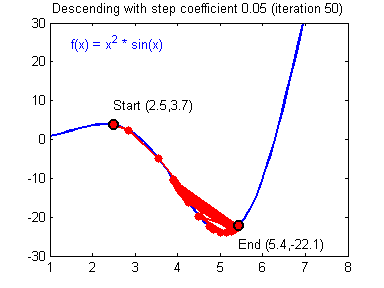
【code】
# GRADED FUNCTION: update_parameters def update_parameters(parameters, grads, learning_rate = 1.2): """ Updates parameters using the gradient descent update rule given above Arguments: parameters -- python dictionary containing your parameters grads -- python dictionary containing your gradients Returns: parameters -- python dictionary containing your updated parameters """ # Retrieve each parameter from the dictionary "parameters" ### START CODE HERE ### (≈ 4 lines of code) W1 = parameters["W1"] b1 = parameters["b1"] W2 = parameters["W2"] b2 = parameters["b2"] ### END CODE HERE ### # Retrieve each gradient from the dictionary "grads" ### START CODE HERE ### (≈ 4 lines of code) dW1 = grads["dW1"] db1 = grads["db1"] dW2 = grads["dW2"] db2 = grads["db2"] ## END CODE HERE ### # Update rule for each parameter ### START CODE HERE ### (≈ 4 lines of code) W1 = W1- learning_rate*dW1 b1 = b1- learning_rate*db1 W2 = W2- learning_rate*dW2 b2 = b2- learning_rate*db2 ### END CODE HERE ### parameters = {"W1": W1, "b1": b1, "W2": W2, "b2": b2} return parameters
parameters, grads = update_parameters_test_case() parameters = update_parameters(parameters, grads) print("W1 = " + str(parameters["W1"])) print("b1 = " + str(parameters["b1"])) print("W2 = " + str(parameters["W2"])) print("b2 = " + str(parameters["b2"]))
【result】
W1 = [[-0.00643025 0.01936718] [-0.02410458 0.03978052] [-0.01653973 -0.02096177] [ 0.01046864 -0.05990141]] b1 = [[ -1.02420756e-06] [ 1.27373948e-05] [ 8.32996807e-07] [ -3.20136836e-06]] W2 = [[-0.01041081 -0.04463285 0.01758031 0.04747113]] b2 = [[ 0.00010457]]
Expected Output:
| W1 | [[-0.00643025 0.01936718] [-0.02410458 0.03978052] [-0.01653973 -0.02096177] [ 0.01046864 -0.05990141]] |
| b1 | [[ -1.02420756e-06] [ 1.27373948e-05] [ 8.32996807e-07] [ -3.20136836e-06]] |
| W2 | [[-0.01041081 -0.04463285 0.01758031 0.04747113]] |
| b2 | [[ 0.00010457]] |
4.4 - Integrate parts 4.1, 4.2 and 4.3 in nn_model()
Question: Build your neural network model in nn_model().
Instructions: The neural network model has to use the previous functions in the right order.
【code】
# GRADED FUNCTION: nn_model def nn_model(X, Y, n_h, num_iterations = 10000, print_cost=False): """ Arguments: X -- dataset of shape (2, number of examples) Y -- labels of shape (1, number of examples) n_h -- size of the hidden layer num_iterations -- Number of iterations in gradient descent loop print_cost -- if True, print the cost every 1000 iterations Returns: parameters -- parameters learnt by the model. They can then be used to predict. """ np.random.seed(3) n_x = layer_sizes(X, Y)[0] # (n_x, n_h, n_y) = layer_sizes(X, Y) n_y = layer_sizes(X, Y)[2] # Initialize parameters, then retrieve W1, b1, W2, b2. Inputs: "n_x, n_h, n_y". Outputs = "W1, b1, W2, b2, parameters". ### START CODE HERE ### (≈ 5 lines of code) parameters =initialize_parameters(n_x, n_h, n_y) W1 = np.random.randn(n_h,n_x)*0.01 b1 = np.zeros((n_h,1)) #注意zeros()函数初始化的写法 W2 = np.random.randn(n_y,n_h)*0.01 b2 = np.zeros((n_y,1)) ### END CODE HERE ### # Loop (gradient descent) for i in range(0, num_iterations): ### START CODE HERE ### (≈ 4 lines of code) # Forward propagation. Inputs: "X, parameters". Outputs: "A2, cache". A2, cache = forward_propagation(X, parameters) # Cost function. Inputs: "A2, Y, parameters". Outputs: "cost". cost =compute_cost(A2, Y, parameters) # Backpropagation. Inputs: "parameters, cache, X, Y". Outputs: "grads". grads = backward_propagation(parameters, cache, X, Y) # Gradient descent parameter update. Inputs: "parameters, grads". Outputs: "parameters". parameters = update_parameters(parameters, grads, learning_rate = 1.2) ### END CODE HERE ### # Print the cost every 1000 iterations if print_cost and i % 1000 == 0: print ("Cost after iteration %i: %f" %(i, cost)) return parameters
X_assess, Y_assess = nn_model_test_case() parameters = nn_model(X_assess, Y_assess, 4, num_iterations=10000, print_cost=True) print("W1 = " + str(parameters["W1"])) print("b1 = " + str(parameters["b1"])) print("W2 = " + str(parameters["W2"])) print("b2 = " + str(parameters["b2"]))
【result】
Cost after iteration 0: 0.692739 Cost after iteration 1000: 0.000218 Cost after iteration 2000: 0.000107 Cost after iteration 3000: 0.000071 Cost after iteration 4000: 0.000053 Cost after iteration 5000: 0.000042 Cost after iteration 6000: 0.000035 Cost after iteration 7000: 0.000030 Cost after iteration 8000: 0.000026 Cost after iteration 9000: 0.000023 W1 = [[-0.65848169 1.21866811] [-0.76204273 1.39377573] [ 0.5792005 -1.10397703] [ 0.76773391 -1.41477129]] b1 = [[ 0.287592 ] [ 0.3511264 ] [-0.2431246 ] [-0.35772805]] W2 = [[-2.45566237 -3.27042274 2.00784958 3.36773273]] b2 = [[ 0.20459656]]
Expected Output:
| cost after iteration 0 | 0.692739 |
| W1 | [[-0.65848169 1.21866811] [-0.76204273 1.39377573] [ 0.5792005 -1.10397703] [ 0.76773391 -1.41477129]] |
| b1 | [[ 0.287592 ] [ 0.3511264 ] [-0.2431246 ] [-0.35772805]] |
| W2 | [[-2.45566237 -3.27042274 2.00784958 3.36773273]] |
| b2 | [[ 0.20459656]] |
4.5 Predictions
Question: Use your model to predict by building predict(). Use forward propagation to predict results.
Reminder:
As an example, if you would like to set the entries of a matrix X to 0 and 1 based on a threshold you would do: X_new = (X > threshold)
【code】
# GRADED FUNCTION: predict def predict(parameters, X): """ Using the learned parameters, predicts a class for each example in X Arguments: parameters -- python dictionary containing your parameters X -- input data of size (n_x, m) Returns predictions -- vector of predictions of our model (red: 0 / blue: 1) """ # Computes probabilities using forward propagation, and classifies to 0/1 using 0.5 as the threshold. ### START CODE HERE ### (≈ 2 lines of code) A2, cache = forward_propagation(X, parameters) # cache -- a dictionary containing "Z1", "A1", "Z2" and "A2" predictions =(A2>0.5) ### END CODE HERE ### return predictions
parameters, X_assess = predict_test_case() predictions = predict(parameters, X_assess) print("predictions mean = " + str(np.mean(predictions)))
【result】
predictions mean = 0.666666666667
Expected Output:
| predictions mean | 0.666666666667 |
It is time to run the model and see how it performs on a planar dataset. Run the following code to test your model with a single hidden layer of nhnh hidden units.
【code】
# Build a model with a n_h-dimensional hidden layer parameters = nn_model(X, Y, n_h = 4, num_iterations = 10000, print_cost=True) # Plot the decision boundary plot_decision_boundary(lambda x: predict(parameters, x.T), X, Y) plt.title("Decision Boundary for hidden layer size " + str(4))
【result】
Expected Output:
| Accuracy | 90% |
Accuracy is really high compared to Logistic Regression. The model has learnt the leaf patterns of the flower! Neural networks are able to learn even highly non-linear decision boundaries, unlike logistic regression.
Now, let's try out several hidden layer sizes.
【中文翻译】
4.6 - Tuning hidden layer size (optional/ungraded exercise)
Run the following code. It may take 1-2 minutes. You will observe different behaviors of the model for various hidden layer sizes.
【code】
# This may take about 2 minutes to run plt.figure(figsize=(16, 32)) hidden_layer_sizes = [1, 2, 3, 4, 5, 20, 50] for i, n_h in enumerate(hidden_layer_sizes): plt.subplot(5, 2, i+1) # ??? plt.title('Hidden Layer of size %d' % n_h) parameters = nn_model(X, Y, n_h, num_iterations = 5000) plot_decision_boundary(lambda x: predict(parameters, x.T), X, Y) # ??? predictions = predict(parameters, X) accuracy = float((np.dot(Y,predictions.T) + np.dot(1-Y,1-predictions.T))/float(Y.size)*100) print ("Accuracy for {} hidden units: {} %".format(n_h, accuracy))
【result】
Accuracy for 1 hidden units: 67.5 % Accuracy for 2 hidden units: 67.25 % Accuracy for 3 hidden units: 90.75 % Accuracy for 4 hidden units: 90.5 % Accuracy for 5 hidden units: 91.25 % Accuracy for 20 hidden units: 90.0 % Accuracy for 50 hidden units: 90.25 %
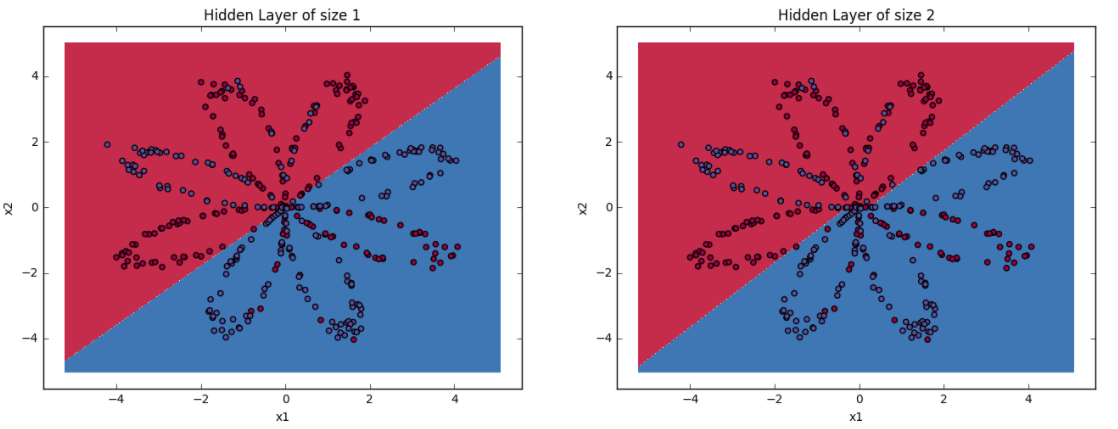

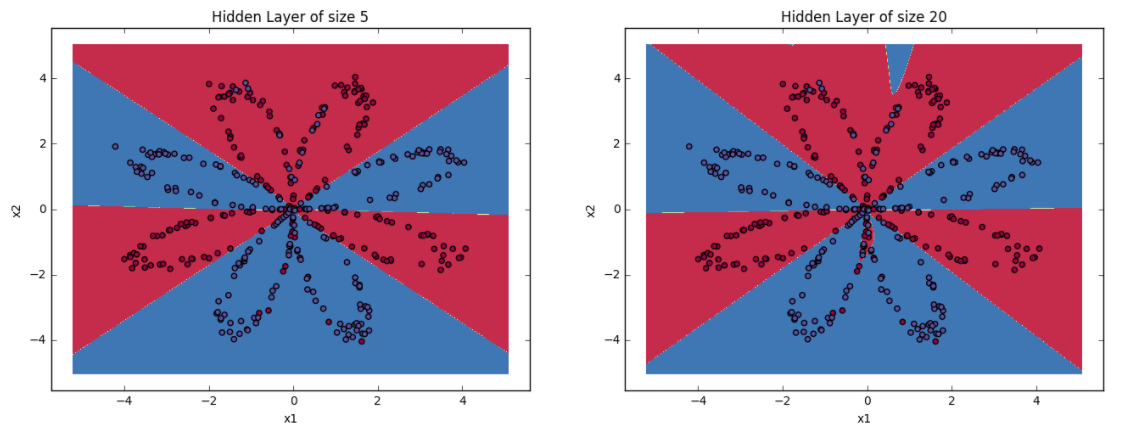
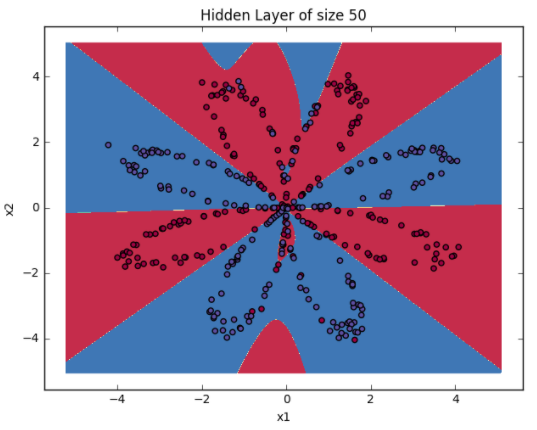
Interpretation:
- The larger models (with more hidden units) are able to fit the training set better, until eventually the largest models overfit the data.
- The best hidden layer size seems to be around n_h = 5. Indeed, a value around here seems to fits the data well without also incurring noticable overfitting.
- You will also learn later about regularization, which lets you use very large models (such as n_h = 50) without much overfitting.
Optional questions:
Note: Remember to submit the assignment but clicking the blue "Submit Assignment" button at the upper-right.
Some optional/ungraded questions that you can explore if you wish:
- What happens when you change the tanh activation for a sigmoid activation or a ReLU activation?
- Play with the learning_rate. What happens?
- What if we change the dataset? (See part 5 below!
You've learnt to:
- Build a complete neural network with a hidden layer
- Make a good use of a non-linear unit
- Implemented forward propagation and backpropagation, and trained a neural network
- See the impact of varying the hidden layer size, including overfitting.
Nice work!
5) Performance on other datasets
If you want, you can rerun the whole notebook (minus the dataset part) for each of the following datasets.
【code】
# Datasets noisy_circles, noisy_moons, blobs, gaussian_quantiles, no_structure = load_extra_datasets() datasets = {"noisy_circles": noisy_circles, "noisy_moons": noisy_moons, "blobs": blobs, "gaussian_quantiles": gaussian_quantiles} ### START CODE HERE ### (choose your dataset) dataset = "blobs" ### END CODE HERE ### X, Y = datasets[dataset] X, Y = X.T, Y.reshape(1, Y.shape[0]) # make blobs binary #变成二进制数 if dataset == "blobs": Y = Y%2 # Visualize the data plt.scatter(X[0, :], X[1, :], c=Y, s=40, cmap=plt.cm.Spectral);
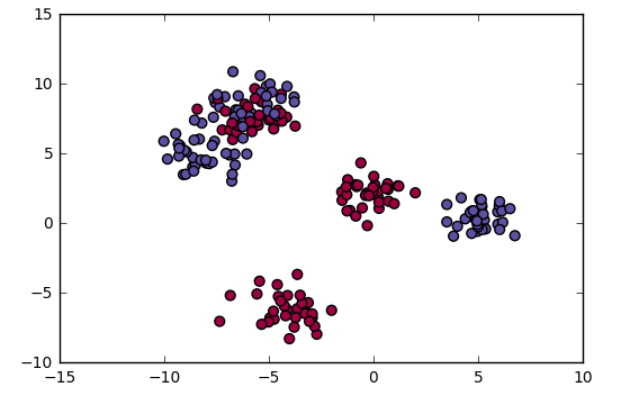
Congrats on finishing this Programming Assignment!
Reference:
